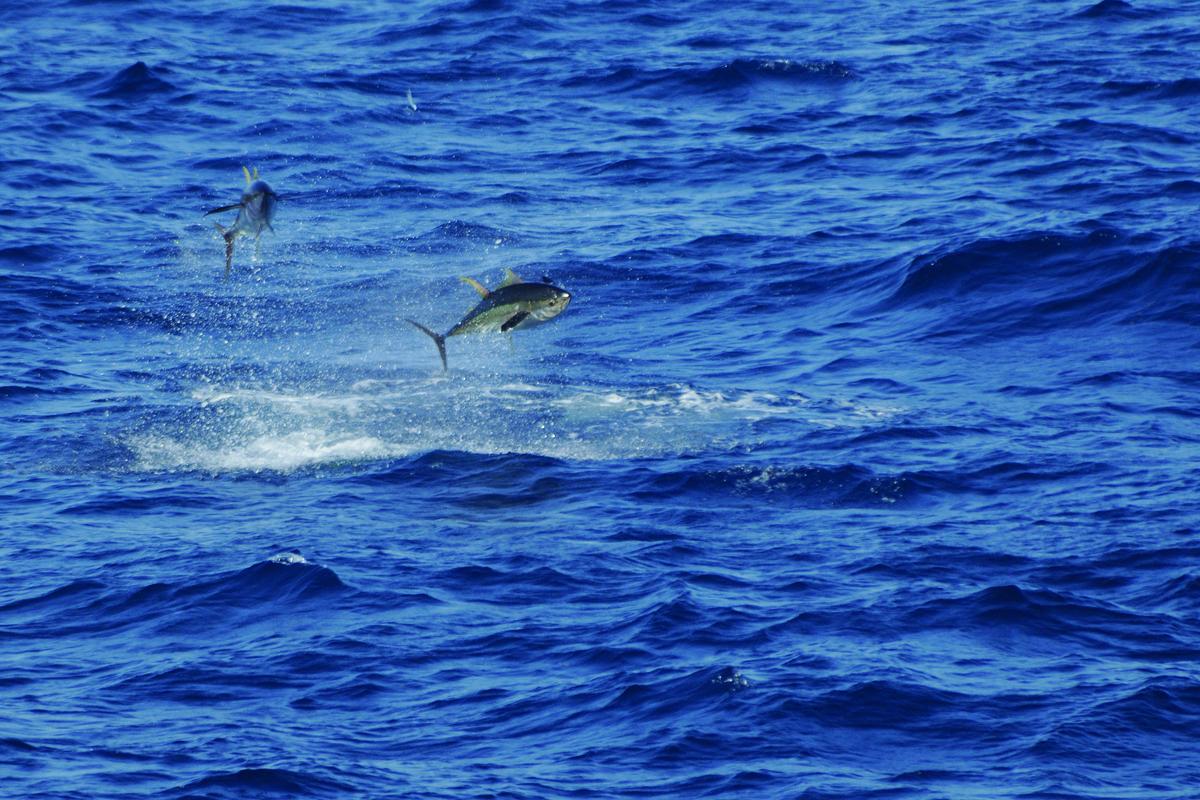
Alex Friedman was getting antsy. Tuna season had opened the day before and he hadn’t gone out because it looked like there would be foul weather offshore. But now, as we sat in Oak Bluffs harbor onboard his thirty-five-foot H&H Downcast F/V, Dazed & Confused, the VHF radio was blurting out conversations between captains and aerial fish spotters who had gone out and apparently they were getting some action.
Friedman, who grew up in Cambridge and now resides in Edgartown, is the current president of the Dukes County Fishermen’s Association. He’s been tuna fishing for a living for about ten years and gave me a rundown of the basics even though his mind was somewhere out on Georges Bank. It starts with permits, lots of them from the state and federal governments.
And since you may be heading a hundred miles out to sea, you’re going to need a seaworthy boat with all the mandated safety equipment, which for commercial fishermen includes survival suits, a life raft, and more. Ideally, you want something between thirty and forty feet long. Most important, of course, you need a fish: bluefin, bigeye, yellowfin, and albacore tuna are the species commonly found in our waters. Bluefin can weigh as much as 1,500 pounds; bigeye and yellowfin about 450 pounds; and albacore 80 pounds.
“We have the Labrador Current coming down from the north and it carries bait-rich cold water, and the Gulf Stream comes up from the south,” says Friedman. “Where those currents meet is where the fish are.”
Specifically, he’s talking about Georges Bank and the Canyons. The Canyons mark the edge of the continental shelf, while the legendary Georges Bank starts 117 miles east of the Vineyard and is bigger than the state of Massachusetts. Another prime fishing ground is Stellwagen Bank, stretching from north of Provincetown to Cape Ann. Sure, you can sometimes find fish ten miles offshore, but your chances are slim.
It hasn’t always been that way. The 1980s was the golden age of tuna and swordfishing between the Vineyard and Block Island. The boom, as usual, resulted in a crash, and tuna stocks are only recently showing signs of recovery. Thanks to strict catch limits enacted in 2009, the western Atlantic bluefin population had grown 13 percent by 2013. However, the species is still depleted, and the annual catch limit of 1,750 metric tons is less than a tenth of what was caught in the 1960s.
Once in the fishing grounds, there are several ways to catch tuna. Recreational fishermen often cast for tuna, but “if you try to land anything much over 150 pounds from a spinning rod, you’re going to the hospital,” says Friedman. More often fishermen either troll, dragging a lure or live bait behind the boat at six to twelve knots, drift, or anchor with baited hooks on multiple lines. Often the lines are rigged to balloons or kites that hold the bait near the surface.
When a balloon pops and the rod bends, you know you’ve got a fish on and it’s time to turn on the engines and get ready for a fight. “Their first run is generally 300 to 1,000 yards and they’re unstoppable – you have to let them go,” says Friedman. “After that, you’re constantly backing down and pulling away with the boat.”
It can take more than six hours to boat a giant fish. When they get within about twenty feet, they are harpooned, which often sends them on another run. “Finally, when we get them close enough to the boat, we gaff them and put a tail rope on them,” says Friedman.
The most challenging way to hunt tuna is to harpoon them directly from a boat with a tower for spotting the fish and a pulpit that extends some twenty feet out from the bow, from which to throw the harpoon. It only works on calm and glare-free days, and only with bluefin, which are warm blooded and frequent the surface. “Harpooning is one of the hardest things I’ve ever done,” says Friedman. “Tuna are extremely fast and intelligent and sometimes you have to throw the harpoon as far as a hundred feet.”
But harpooning can also be the most rewarding. Harpoons can be equipped with an electronic charge that instantly kills the tuna. Not only is it arguably the most humane way to fish, but a tuna that dies instantly will also fetch a better price at the market since it hasn’t had to fight for several hours, which affects the meat.
A few days after our first meeting, Friedman is noticeably more upbeat and relaxed. He had just come back from his first trip out and had harpooned three tuna. For fishermen, there’s nothing like a good first trip and he spoke with unguarded optimism. “It’s gonna be a good year,” he said.
Assuming you’re not a tuna.




